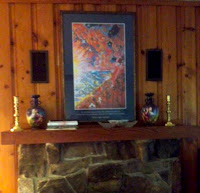 |
| Print of painting by Walter Anderson |
On this rainy day in Sewanee, Tennessee that seems to be the way the weather will be for nigh on a week, I go on Facebook.com and see a picture of my grandson Martin teaching my great-grandson Alex how to golf (my great-grandson is four years old!). They're staying at the Villa of Hickory Hills in Mississippi where his godmother and I took Martin at age five, and for many years after, to enjoy golfing and the nearby Gulf. It's there at Gauthier, Mississippi that I first learned about the artist Walter Anderson whose home was in Ocean Springs on the Mississippi Coast, only a few miles away from Gauthier.
When we owned the timeshare at Gauthier, I always visited the Walter Anderson Museum where I became enchanted with the murals of Anderson's "Walls of Light" at the Shearwater Cottage. Today, as rain falls in heavy sheets from a gray sky, I think of Anderson's walls of light and stand before a print showing part of the cottage mural that hangs in my living room here at Sewanee, the flaming colors lighting up an otherwise dull day. Anderson, who saw color everywhere, captured the light of the sky, trees, and grass and wrote: "the dawn was magnificent. Sky was vermilion and blue and all the tree trunks turned pink and the grass peach color. Then I heard the cranes for the first time...metallic and in perfect keeping with the setting..."
Anderson was a brilliant New Orleans-born painter, a southern artist who was both mystic and madman. He trained at the Pennsylvania Academy of the Fine Arts and later painted radiant pictures of the surrounding Mississippi landscape and its wildlife, often working under a makeshift shelter on Horn Island in the Mississippi Gulf. He painted the murals in the Ocean Springs Community Center and created designs for pottery, pictures of animal life, hundreds of hand-colored linoleum block prints, and after he died, when family members went into the cottage where he lived, alone, beside their home, they discovered hundreds of watercolors he had never shown. In a wooden chamber he called "the little room," Anderson had painted the ceiling and walls with birds that burst into flame, plants that became butterflies, a sun on the ceiling, and cats stalking prey in tall grass.
I admire Anderson's work as that of a great artist who worked in all mediums and mastered all of them, but it is his paintings of nature and the mystic quality evident in his murals that enchant me. Anne King describes him as a "paradox in life, torn between the responsibilities of the concentric, a term he used to denote the social order of the workaday world, and the bliss of the eccentric, a state of oneness with nature as the artist-creator..." (Walls of Light,The Murals of Walter Anderson).
Anderson developed his love of nature and the arts at a young age when he accompanied his father and brothers hunting and fishing on Lake Pontchartrain and in the marshes of Louisiana, and he also spent time observing nature while vacationing at his mother's family home on the Mississippi Gulf Coast. In all these places, he developed his vision of nature that would become realized in his art.
Beneath the copy of the mural painting in my living room are his words about the melding of nature and art: "The Third poetry is sometimes never written but when it is, it's by those who have brought nature and art together in one thing."
I envy Martin and his little family as they enjoy the Villas of Hickory Hills...mostly because I miss my favorite art show in the Walter Anderson Museum of Art where Anderson created a rich vision of the natural world.
Note: Dr. Victoria I. Sullivan, a botanist, describes the flora and fauna in all of Anderson's murals in an article entitled "Plant Life 'Realizations' in the Murals of Walter Anderson," published in Interdisciplinary Humanities, 2004-2005. One of my poems entitled "On First Looking Into Anderson's Refuge," was published in the same issue.













No comments:
Post a Comment